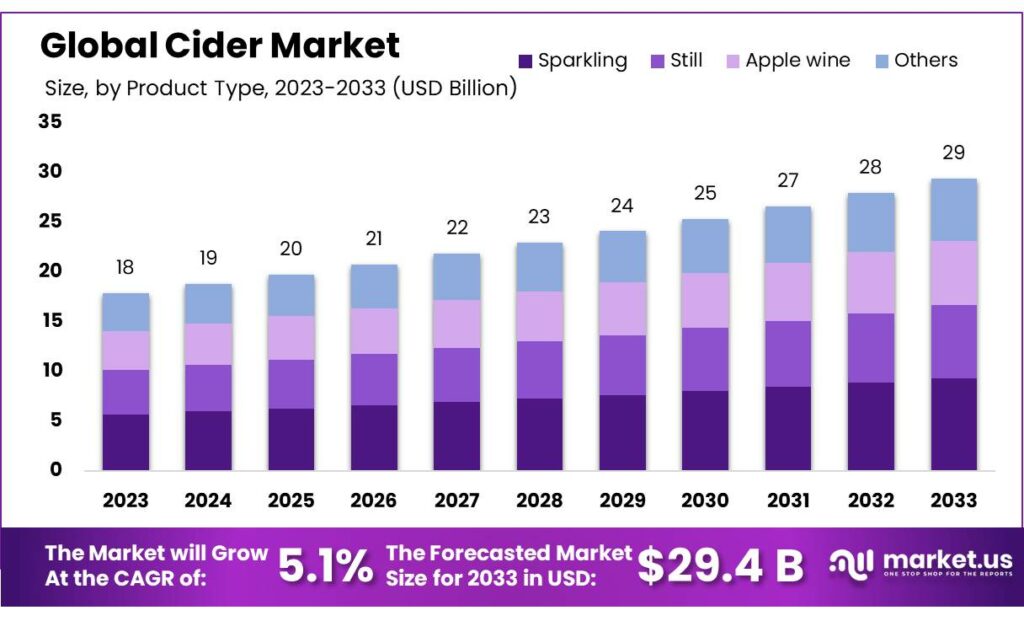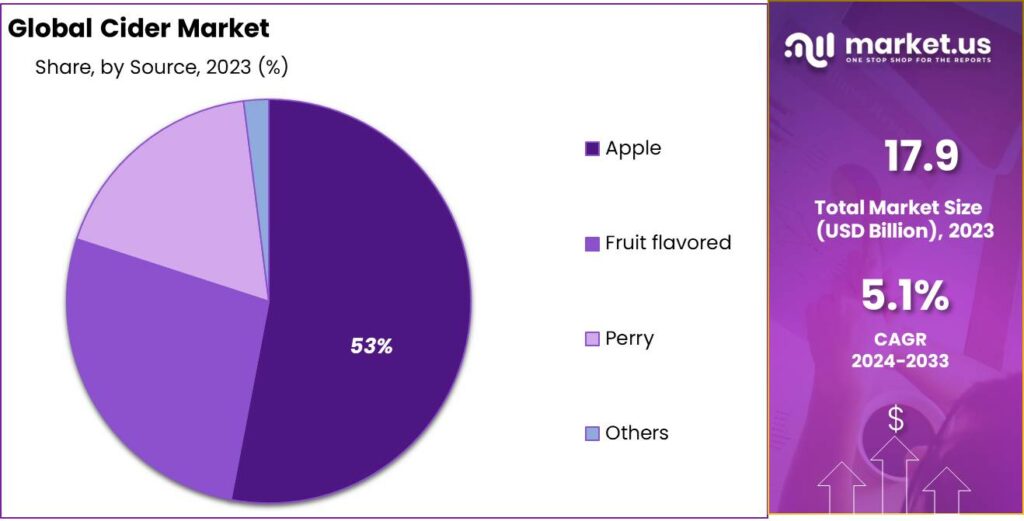Table of Contents
- Introduction
- Editor’s Choice
- Global Cider Market Overview
- Global Cider, Perry, and Rice Wine Market
- Volume Per Capita Consumption of Cider, Perry, and Rice Wine
- Price of Cider, Perry, and Rice Wine
- Top Cider-Exporting Nations
- Top Cider Importing Nations
- Cider Flavor Preferences
- Consumer Preferences and Buying Patterns for Cider
- Health Beliefs of Cider Drinkers
Introduction
According to Cider Statistics, Cider, witnessing a global resurgence, is an alcoholic drink made mainly from fermented apple juice, with pear (perry) and flavored variants also popular.
Its production involves selecting quality fruit, fermenting with yeast, aging for flavor, blending, and packaging.
Cider appeals for its range from dry to sweet, clear to cloudy, and still to sparkling, attracting those looking for beer and wine alternatives.
With an ABV of 4%-8%, its natural, gluten-free appeal has fueled the craft and artisanal cider market growth, focusing on local ingredients and new flavors.
The sector’s expansion is driven by consumer preferences for premium, unique beverages, suggesting a promising future for cider, underscored by quality, diversity, and eco-consciousness.
Editor’s Choice
- In 2023, the global cider market generated USD 18.0 billion in revenue.
- North America commands a significant portion with a 25.0% market share, indicating its substantial presence in the industry.
- SABMiller Plc and Heineken N.V. lead the pack with respective market shares of 17% and 18%, showcasing their significant presence and competitive strength.
- The volume per capita consumption of cider, perry, and rice wine is projected to reach 6.07 liters per capita.
- The global cider market sees significant export activity from various nations, with France emerging as the leading exporter, shipping approximately 24,457 units.
- The United States is the top cider-importing nation, receiving 19,765 shipments.
- Compared to other drinkers, those who regularly consume were more inclined to strive for a balanced and nutritious diet, with 84% expressing this intention compared to 80% of other drinkers.

Global Cider Market Overview
Global Cider Market Size
- The global cider market is experiencing steady growth, with revenues projected to rise consistently over the coming years at a CAGR of 5.1%.
- In 2023, the market generated USD 18.0 billion in revenue, a figure that increased to USD 19.0 billion in 2024.
- This upward trend is expected to continue, reaching USD 20.0 billion in 2025, USD 21.0 billion in 2026, and USD 22.0 billion in 2027.
- The growth trajectory persists, culminating in an estimated revenue of USD 29.0 billion by the year 2033.

Regional Analysis of the Global Cider Market
- As of the latest data, North America commands a significant portion with a 25.0% market share, indicating its substantial presence in the industry.
- Following closely, Europe holds the largest share at 36.8%, underscoring its prominence as a critical market for cider consumption and production.
- The Asia-Pacific (APAC) region contributes notably as well, representing 27.0% of the market share, reflecting the growing popularity of cider in this region.
- South America and the Middle East & Africa (MEA) regions hold smaller but still notable shares, with 7.0% and 4.2%, respectively.

Competitive Analysis of the Global Cider Market
- SABMiller Plc and Heineken N.V. lead the pack with respective market shares of 17% and 18%, showcasing their significant presence and competitive strength.
- Halewood Wines & Spirits and Distell Group Limited are closely behind, each holding 9% and 8% of the market, respectively.
- The C&C Group Plc and Carlsberg A/S Plc share an equal portion, each commanding 8% of the market.
- Aston Manor Brewery and Diageo plc maintain a similar standing with a 6% market share each.
- Collectively, these top players hold a substantial portion of the market, while the remaining 22% is distributed among other key players.

Global Cider, Perry, and Rice Wine Market
Revenue Per Capita
- The revenue per capita in the cider, perry, and rice wine market has fluctuated over the past decade.
- In 2018, it stood at USD 14.06, experiencing a marginal decrease to USD 14.05 in 2019.
- From 2023 onwards, a steady upward trajectory is observed, reaching USD 14.36 in 2023 and notably increasing to USD 15.97 in 2024.
- This positive momentum continues, with revenue per capita climbing to USD 17.16 in 2025, USD 18.48 in 2026, and USD 19.90 in 2027.
- By 2028, the figure surpasses the USD 20 mark, reaching USD 21.36, indicating sustained growth and potentially evolving market dynamics driving increased consumer spending in this sector.

Global Cider, Perry, and Rice Wine Market Share – By Distribution Channel
- The distribution channels for the global cider, perry, and rice wine market have evolved over the years, reflecting changing consumer preferences and market dynamics.
- In 2017, offline channels dominated with a share of 98.7%, while online channels accounted for a mere 1.3%. However, there has been a gradual shift towards online platforms in subsequent years.
- Meanwhile, online channels consistently grew, reaching 5.1% in 2025 and 5.2% in 2026.
- By 2027, online channels accounted for 5.3% of the market share, highlighting the ongoing shift towards e-commerce platforms for purchasing cider, perry, and rice wine products.

Volume Per Capita Consumption of Cider, Perry, and Rice Wine
- The volume per capita consumption of cider, perry, and rice wine has demonstrated slight fluctuations over the years, reflecting changes in consumer habits and market dynamics.
- In 2018, consumption stood at 6.00 liters per capita, experiencing a marginal increase to 6.02 liters in 2019.
- However, there was a decline in 2020, with consumption dropping to 5.71 liters per capita.
- From 2022 onwards, there’s a stabilization of consumption levels, hovering around 5.58 to 5.73 liters per capita.
- By 2028, there’s a gradual increase, reaching 6.07 liters per capita, indicating potential shifts in consumer preferences or market influences driving higher consumption levels in the cider, perry, and rice wine market.

Price of Cider, Perry, and Rice Wine
- The price of cider, perry, and rice wine has experienced fluctuations over the past decade, reflecting changes in market conditions and consumer demand.
- In 2018, the price stood at USD 2.35 per unit, followed by a slight decrease to USD 2.34 in 2019.
- However, there was a more notable decline in 2020, with the price dropping to USD 2.21, potentially influenced by factors such as production costs or market competition.
- In 2028, the price will reach USD 3.52 per unit, reflecting sustained growth and potentially increased market value within the industry.

Top Cider-Exporting Nations
- The global cider market sees significant export activity from various nations, with France emerging as the leading exporter, shipping approximately 24,457 units.
- Spain closely follows, with 23,430 shipments, demonstrating its substantial contribution to the international cider trade.
- The Netherlands also plays a prominent role, exporting 20,447 units, while Italy and Germany follow closely behind, with 18,990 and 16,389 shipments, respectively.
- Belgium and the United Kingdom contribute significantly as well, with 12,790 and 12,430 shipments, respectively.
- Poland and Austria are among the top cider-exporting nations, with 10,399 and 9,701 units shipped, respectively.

Top Cider Importing Nations
- In the global trade landscape, certain nations stand out as prominent importers, reflecting their consumption patterns and market demand.
- The United States leads the way as the top cider-importing nation, receiving 19,765 shipments.
- The Netherlands follows with 13,847 shipments, while Germany imports 10,732 units, showcasing its significant role in the international cider market.
- France and Spain also feature prominently as importers, with 8,134 and 7,605 shipments, respectively.
- Additionally, Austria, the United Kingdom, Belgium, Italy, and Sweden all contribute substantially to cider imports, each receiving between 6,144 and 6,660 shipments.

Cider Flavor Preferences
- In Great Britain in 2022, the consumption of varied across different flavors, reflecting diverse consumer preferences within the market.
- The most popular flavor was apple, with approximately 9,175 people using apple-flavored cider.
- Berry-flavored cider also garnered significant attention, with 5,590 people enjoying this variation.
- Other fruit flavors accounted for 4,799 users, followed by pear-flavored cider, which attracted 3,543 consumers.
- One thousand two hundred forty-nine individuals favored rose-flavored cider, while 808 people chose low-alcohol or alcohol-free options.

Consumer Preferences and Buying Patterns for Cider
Drinking Habits
- Consumer preferences and buying patterns for cider, particularly among individuals from producing regions, exhibit distinct drinking habits based on frequency.
- In these regions, a notable portion of men, approximately 66%, indulge in daily consumption of cider, showcasing a preference for regular and frequent consumption.
- Conversely, women from producing regions demonstrate a slightly lower daily consumption rate, at 48%.
- Weekly consumption habits are prevalent among both genders, with 74% of men and 61% of women enjoying every week, suggesting a consistent and routine preference for the beverage.
- Occasional consumption is also observed, albeit less frequently, with 26% of men and 37% of women opting occasionally.

Purchasing Location
- Consumer preferences and buying patterns for cider in producing regions also reveal distinct trends in purchasing locations.
- Supermarkets emerge as the most popular choice among both men and women, with a significant majority favoring this convenient retail option.
- Specifically, 89% of men and an even higher proportion of women, 96%, prefer purchasing cider from supermarkets, indicating the convenience and accessibility of these outlets for obtaining their preferred beverage.
- Liquor stores are another common purchasing location, albeit less frequently chosen compared to supermarkets.
- Approximately 20% of men and 13% of women opt for purchasing from liquor stores, suggesting a preference for specialized alcohol retailers.
- Interestingly, a sizable portion of consumers from producing regions, comprising 34% of men and 46% of women, prefer buying cider directly from the producer, highlighting a preference for supporting local producers or seeking out unique varieties directly from the source.

Health Beliefs of Cider Drinkers
- In general, individuals who regularly consume reported making efforts to maintain a healthy diet, although they held mixed views regarding the role of alcohol in overall health.
- Compared to other drinkers, those who regularly consume cider were more inclined to strive for a balanced and nutritious diet, with 84% expressing this intention compared to 80% of other drinkers.
- However, they were less likely to agree with the notion that alcohol cannot be a part of a healthy lifestyle, with only 24% of regular drinkers endorsing this statement compared to 30% of other drinkers.
- While a significant portion of the population acknowledges that Australians have issues with alcohol, only 28% admitted to sometimes consuming too much or feeling uneasy about their drinking habits.
Discuss your needs with our analyst
Please share your requirements with more details so our analyst can check if they can solve your problem(s)



